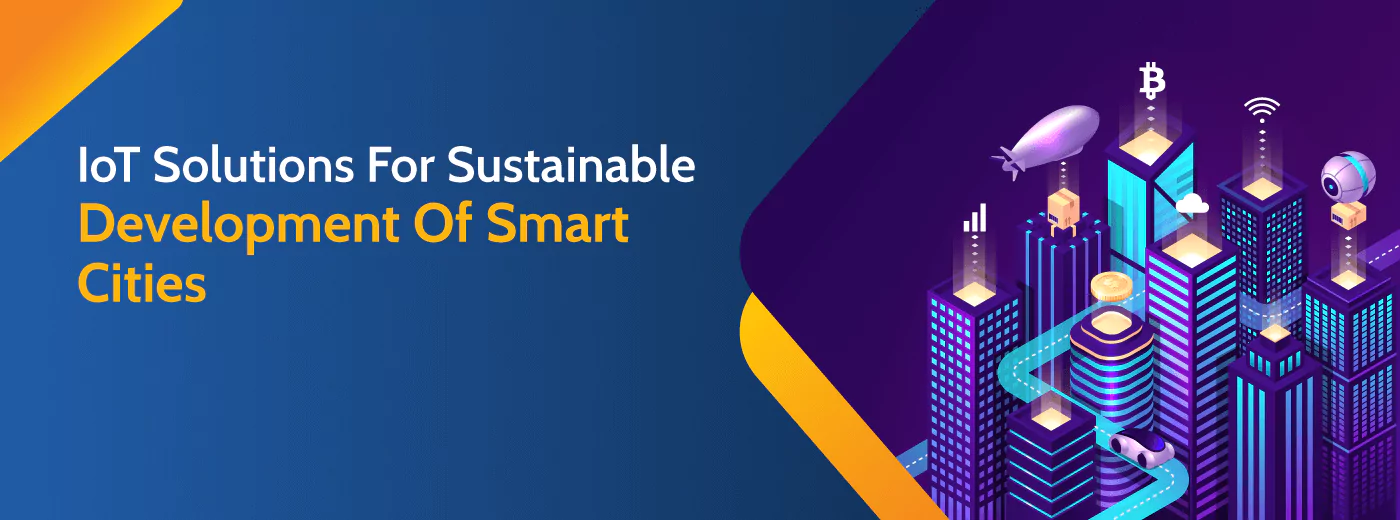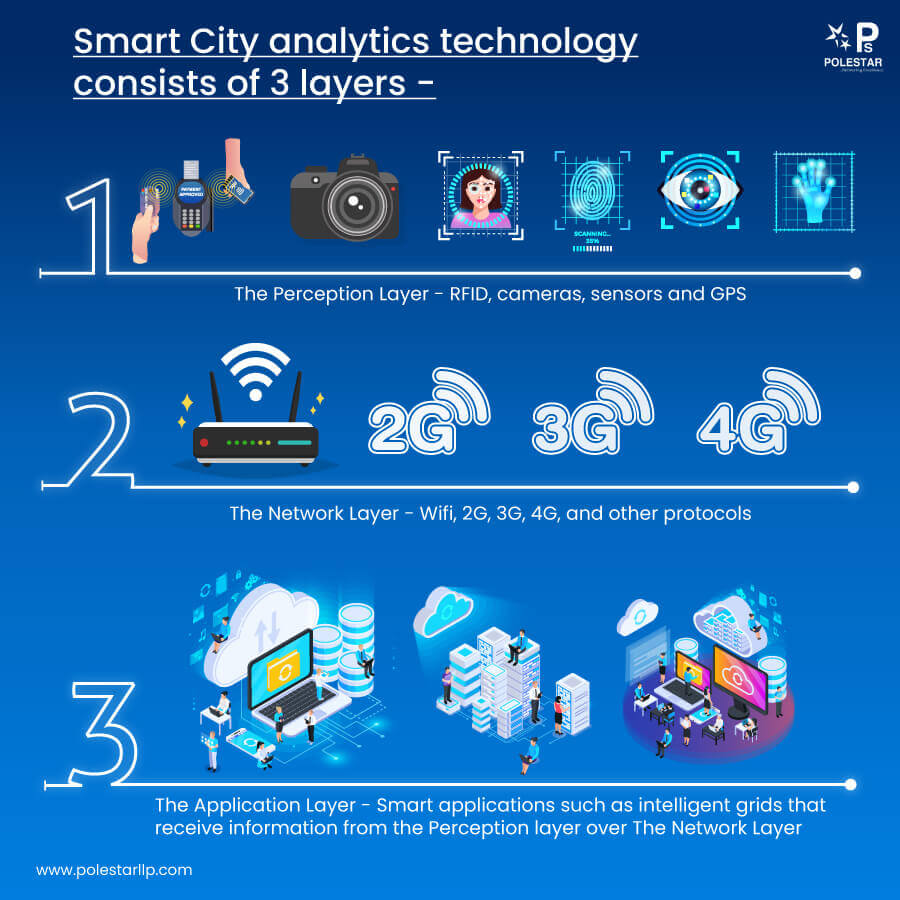
Sign up to receive latest insights & updates in technology, AI & data analytics, data science, & innovations from Polestar Analytics.
The history of human settlement has mostly been rural with low-density settlements. However, this feature has been changing rapidly, and our world is getting increasingly urbanized. Globally, it is expected that the population of “megacities”, or cities that house more than 10 mn people, will increase from 33 in 2018 to 43 in 2030. And, by 2030, it is projected that cities with at least 1 mn inhabitants will house 28% of the 10 bn plus global population.
Smart cities using IoT are using analytics and data from sensors to design better civic amenities and deliver better standards of living and cost-effective public services. With the rise in population in cities and the corresponding increased stressors on the natural and civic resources, civic administrators are coming up with interesting ways to utilize their data, IT infrastructure and using IoT applications in smart cities to deploy advanced models that will help them solve the challenges of urban planning efficiently and effectively.
28 percent of people worldwide will be concentrated in cities with at least 1 million inhabitants. Smart cities leveraging technological advances to deliver a superior quality of living to the residents have, therefore become a critical public policy planning element.
With the rise in the global population, it has become imperative for governments to design a sustainable and environmentally-friendly future, to ensure the well-being of the people and curtail global warming. Major global cities have pledged to adopt sustainable practices and ensure significant cut-downs along critical dimensions and support the UN Sustainable Development Goals progress.
For example, the WWF has collaborated with several global cities to ensure No Plastic by 2030. It has encouraged these cities to design active pilots and come up with actionable plans to meet the goals by engaging all stakeholders – government, businesses, and the public. Technology is helping provide a common platform for sharing knowledge and ideas so that the stakeholders have access to useful information.
Analytics and the Internet of Things are emerging as a pivotal technology that can help governments reach success milestones.
There are many applications of IoT in smart cities, but these are dependent on collecting the necessary data from sensors, IoT and other available technologies. After collecting data, there needs to be the necessary infrastructure in place to process it, store it and manage it.
This can be costly, depending upon the use cases desired by the smart city infrastructure, hence the cities must judiciously allocate resources and optimize the investments. Analytics in sustainable development can utilize the features to deliver a superior and sustainable working model to address the growing population while adhering to the UN SDGs
Some of the components that make up the data infrastructure for IoT in smart cities are - sensors ( which collect data and send it to the cloud), actuators - which control the movement of the component or device, cloud gateways to ensure secure data flow and access, data lakes, data warehouses to store the data and ensure that it can be accessed speedily.
The technology uses data gathered via sensors, actuators, smartphones and smart applications, which is then collected and analyzed.

Smart City IoT Technology Architecture
Cost-effective and accessible technologies using analytics from connected devices are helping the cities monitor in real-time, implement evidence-based actions and track their progress. In the Netherlands, for example, homes are being equipped with smart energy meters and automobiles embedded with smart usage tracking and routing technologies.
Below are crucial areas where IoT solutions and data analytics technologies are helping the cities reduce their environmental footprint and the collective impact of their prospering communities and helping to create a more sustainable and eco-friendly city for a healthier and happier planet.
Data-driven waste management is already revolutionizing and helping municipalities across the globe reduce their OPEX, save costs, improve citizen’s health and become environmentally responsible. Sensors fitted into sewer pipes are helping identify and detect risks such as leaks of dangerous gases like H2S, and advanced analytics is helping with preventive maintenance. Using data analytics along with infrared and aerial surveillance technologies, governments can actively monitor if companies are illegally polluting the waters with untreated waste.
Other cutting-edge technologies such as IoT-enabled smart garbage systems, machine-to-machine connectivity and route optimization are promising to transform the entire process of waste collection to become more efficient and lead to less fuel consumption on the road.
Governments are making efforts to identify the scale of the problem, design incentive programs, improve transportation and collection methods and track the sale of recycled items to make informed decisions. Governments are using tracking technology through RFID tags, and collecting important data points such as per capita waste generation rates, disposal rates, greenhouse gas emissions savings, diversion and recycling rates, and participation rates. The technology is helping them to design and implement better solid waste management strategies.
Smart resource management is critical to ensure that there is no resource shortage/ overshoot, and that might lead to wastage, inefficiency, and stressors on the environment. By using sensor data and deploying machine learning models, smart grid networks can predict demand and behaviour patterns to match the supply demand. By accurately forecasting demand, companies can generate precise amounts of electricity to minimize wastage.
Also, waste collection can be optimized to track when the waste containers are full and to detect leaks in watering and sewerage systems. Smart energy meters monitor, track and provide alerts on the consumption patterns by users. Intelligent resource management with connected devices and IoT will help deliver solutions such as energy metering, smart utility management, traffic control, public transport management, and building management.
With the rising threat of global warming and firm global commitments, as laid out in the Paris Agreement 2015, governments are trying to address pollution vigorously and meet targets strictly. Sensors can help monitor and detect pollution and identify the points of natural interventions. Better infrastructure and amenities placement for optimal use will lead to less fuel consumption and greenhouse gas emission.
Activists around the world are collaborating to design and develop open-source hardware and software design for pollution monitoring with low-cost, accessible and remote monitoring solutions. One of the difficulties with pollution crackdowns has been a lack of data.
Low-cost sensors are going to change that giving the power of real-time pollution monitoring at multiple locations. For example, many national parks in Kyiv, Ukraine have been fitted with these sensors to monitor air pollution levels. Analytics is empowering local communities with actionable information and evidence to make wise choices as well as identify and press charges against guilty parties.
Geospatial analytics and surveillance technology are helping city planners better allocate the city land use and increase the green cover within the city. The results are cleaner, greener cities with less wastage and less pollution. Smart applications and spatial big data analytics are helping in the design of effective programmes and bottom-up land use planning in collaboration with citizens. For example, Peru has been using sensors to monitor tree loss.
New Orleans in Louisiana is using image and video surveillance over wetlands to monitor water levels and plant health. Today’s technologies are increasingly allowing the public to contribute to rich datasets with their smartphones for use in soil protection and land management. Data analytics is helping governments set up infrastructure close by and enable easy access to citizens.
Low-cost surveillance, integrated strategies, and big data analytics are helping them to understand and actively monitor socio-environmental system behaviour.
Analytics is helping governments integrate renewable energy usage into their traditional energy usage. Data is also helping to increase the efficiency of public transport and carpooling. IoT is helping renewable energy companies bring efficiency into their processes and reduce costs, by remote monitoring. It is delivering a range of essential benefits such as automated management of wind and solar farms, optimized maintenance schedules, and improved safety by detecting hazards – thus helping the energy companies increase efficiency and improve their bottom line.
HAVE A LOOK: BUILDING-SMART-FACTORIES-WITH-IOT-AND-ANALYTICS-3-BEST-EXAMPLES-OF-IIOT-IN-ACTION
Smart cities are going to be the future of human civilization, and it is essential to combine technology and intelligent planning to create a people-friendly city. With the benefits, there are particular concerns that need to be addressed and managed.
IoT for the smart cities can use an intricate set of variables as inputs into its technology - this complex data lifecycle needs to be shared across different processes and public utility departments. This supercritical infrastructure will become the lifeline for the smart cities, helping manage processes and responsibilities.
However, this is bound to throw up concerns around data privacy since a super-efficient data infrastructure will necessarily rely on personal data-points for designing accurate and scalable models - one that will be utilized across the entire city in order to improve our living conditions and optimize healthcare - but will such a trade-off between privacy and public benefits ethically justifiable, and does not it point to the Orwellian nightmare?
Security of data which will power the smart city infrastructure and governing these data assets are going to be critical. Also, important will be to address the privacy concerns and integrate the data usage with legislations such as the General Data Protection Regulation (GDPR) 2018, California Consumer Privacy Act 2018, etc.
The need is a flexible, scalable, secure and governed platform that will provide the decision-makers with a unified platform to track, analyze and manage smart devices.
About Author

Insights Explorer
If data is oil, then analytics is the combustion engine of this current era.